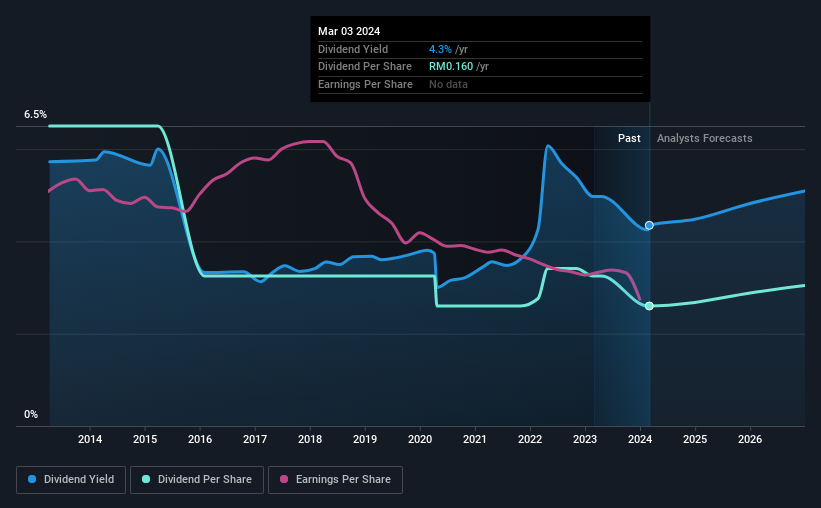We Wouldn't Be Too Quick To Buy Maxis Berhad (KLSE:MAXIS) Before It Goes Ex-Dividend
Readers hoping to buy Maxis Berhad (KLSE:MAXIS) for its dividend will need to make their move shortly, as the stock is about to trade ex-dividend. The ex-dividend date is one business day before the record date, which is the cut-off date for shareholders to be present on the company's books to be eligible for a dividend payment. The ex-dividend date is an important date to be aware of as any purchase of the stock made on or after this date might mean a late settlement that doesn't show on the record date. This means that investors who purchase Maxis Berhad's shares on or after the 8th of March will not receive the dividend, which will be paid on the 21st of March.
The company's next dividend payment will be RM00.04 per share. Last year, in total, the company distributed RM0.16 to shareholders. Based on the last year's worth of payments, Maxis Berhad has a trailing yield of 4.3% on the current stock price of RM03.68. Dividends are an important source of income to many shareholders, but the health of the business is crucial to maintaining those dividends. So we need to investigate whether Maxis Berhad can afford its dividend, and if the dividend could grow.
Check out our latest analysis for Maxis Berhad
If a company pays out more in dividends than it earned, then the dividend might become unsustainable - hardly an ideal situation. Maxis Berhad paid out 126% of profit in the past year, which we think is typically not sustainable unless there are mitigating characteristics such as unusually strong cash flow or a large cash balance. Yet cash flows are even more important than profits for assessing a dividend, so we need to see if the company generated enough cash to pay its distribution. It paid out 78% of its free cash flow as dividends, which is within usual limits but will limit the company's ability to lift the dividend if there's no growth.
It's good to see that while Maxis Berhad's dividends were not covered by profits, at least they are affordable from a cash perspective. If executives were to continue paying more in dividends than the company reported in profits, we'd view this as a warning sign. Extraordinarily few companies are capable of persistently paying a dividend that is greater than their profits.
Click here to see the company's payout ratio, plus analyst estimates of its future dividends.
Have Earnings And Dividends Been Growing?
Companies with falling earnings are riskier for dividend shareholders. If earnings fall far enough, the company could be forced to cut its dividend. Readers will understand then, why we're concerned to see Maxis Berhad's earnings per share have dropped 11% a year over the past five years. When earnings per share fall, the maximum amount of dividends that can be paid also falls.
Another key way to measure a company's dividend prospects is by measuring its historical rate of dividend growth. Maxis Berhad's dividend payments per share have declined at 8.8% per year on average over the past 10 years, which is uninspiring. It's never nice to see earnings and dividends falling, but at least management has cut the dividend rather than potentially risk the company's health in an attempt to maintain it.
To Sum It Up
Has Maxis Berhad got what it takes to maintain its dividend payments? It's never fun to see a company's earnings per share in retreat. Worse, Maxis Berhad's paying out a majority of its earnings and more than half its free cash flow. Positive cash flows are good news but it's not a good combination. Overall it doesn't look like the most suitable dividend stock for a long-term buy and hold investor.
So if you're still interested in Maxis Berhad despite it's poor dividend qualities, you should be well informed on some of the risks facing this stock. Our analysis shows 2 warning signs for Maxis Berhad and you should be aware of them before buying any shares.
A common investing mistake is buying the first interesting stock you see. Here you can find a full list of high-yield dividend stocks.
Have feedback on this article? Concerned about the content? Get in touch with us directly. Alternatively, email editorial-team (at) simplywallst.com.
This article by Simply Wall St is general in nature. We provide commentary based on historical data and analyst forecasts only using an unbiased methodology and our articles are not intended to be financial advice. It does not constitute a recommendation to buy or sell any stock, and does not take account of your objectives, or your financial situation. We aim to bring you long-term focused analysis driven by fundamental data. Note that our analysis may not factor in the latest price-sensitive company announcements or qualitative material. Simply Wall St has no position in any stocks mentioned.

 Yahoo Finance
Yahoo Finance 
